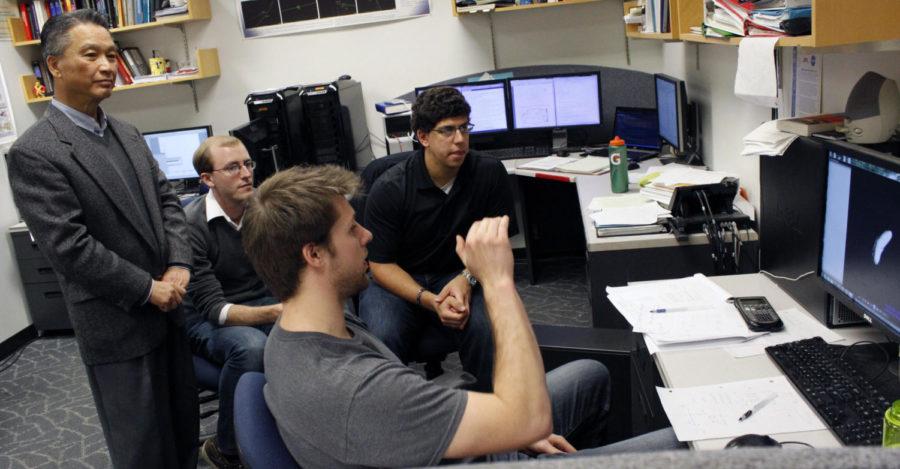Researchers study distances from Earth, the use of nuclear weapons to destroy anticipated asteroids
Caitlin Ellingson/Iowa State Daily
Bong Wie, director of the Asteroid Deflection Research Center, works with graduate students in aerospace engineering Ben Zimmerman, left, Joshua Lyzhoft, and George Vardaxis, right, to study asteroid deflection and ways to predict and destroy asteroids that could pose a threat to the earth.
October 19, 2014
On Feb. 15, 2013, an asteroid exploded over Russia that was believed to be 19 meters in diameter.
The asteroid struck the city of Chelyabinsk and injured more than 1,000 people, according to bbc.com.
The Chelyabinsk asteroid caused panic around the world. It sparked a serious international interest in developing a plan for what to do to protect the planet from asteroid strikes.
Members of Iowa State’s community are working to solve the problem.
Bong Wie, Vance Coffman Endowed Chair Professor and director of the Asteroid Deflection Research Center, found the issue of asteroid strikes to be a “very fascinating, technically challenging problem.”
Wie founded the ADRC in 2008 to begin solving the problem.
Wie said that asteroid strikes are matter of probability, and the probability is very small. That being said, the number isn’t exactly zero.
On Aug. 30 of this year, a 30-40 meter asteroid was detected, and four days later it flew by Earth, Wie said.
“So far we are very lucky,” said Wie. “Sooner or later, one may hit the Earth. We need to prepare for that.”
George Vardaxis, graduate student in aerospace engineering, said that the ADRC looks at small cases and rare occurrences where an asteroid would be coming close to and potentially impacting Earth. The team works to decide what they would do about it.
Their proposal is to send a nuclear weapon into space to blow it up. This system would be used in cases where there is a short warning time of a year or less.
Vardaxis’ part in the process is locating the asteroid and deciding if it’s in danger of coming into contact with the Earth. He uses computer programs to track the orbits of asteroids.
Vardaxis joined the ADRC because of his interest in “orbit determinations and impact risk assessments.”
Ben Zimmerman, graduate student in aerospace engineering, has the job of blowing up the asteroid. He decides how strong of a nuclear device will be needed for destroying it. Ideally, the asteroid would be blown up into small pieces that would burn up in the atmosphere or not hit the Earth at all.
Zimmerman was drawn to the ADRC by his passion for computers. All of his work is done through computer simulations because experiments with nuclear weapons aren’t allowed.
The ADRC is completing a massive study, and they will put out their final report in December. Recommendations will be made to the government about what should be done.
Wie said that next year an international conference drawing about 300 experts from around the globe will gather to discuss politics, technology, detection issues and planning.
The ADRC received a small amount of funding from NASA, which was sufficient for them to develop the required technology. In the future, much more funding will be needed. An issue that is restricting funding is people who are concerned about asteroid strikes aren’t talking, Wie said.
Currently, the ADRC is working on a conceptual, small scale. They have a pretty good understanding of what they can do, but politicians need to make a decision before they can implement their plans.
“Everything is moving in the right direction, but it’s much slower than I’d like it,” Wie said.







